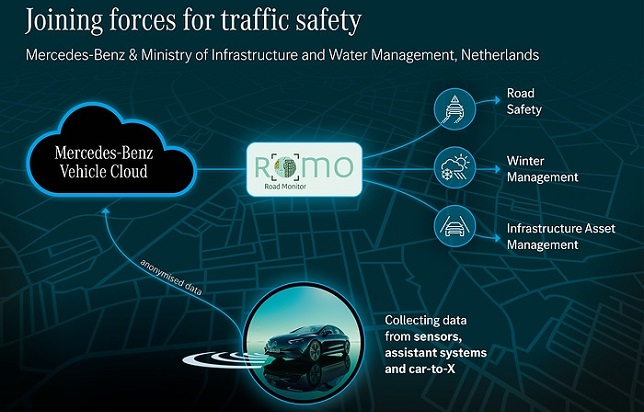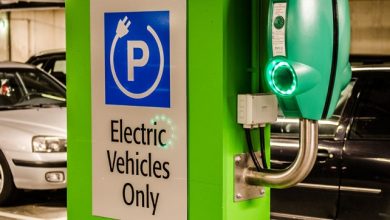Mercedes-Benz wins landmark road monitoring programme in the Netherlands

Mercedes-Benz has been awarded a far-reaching contract for road monitoring through vehicle data by the Netherlands’ Ministry of Infrastructure and Water Management (Min I&W). The project spans two years and covers three key areas: Winter Management, Asset Management and Road Safety. The geographical breadth of the Road Monitor programme (ROMO) extends across all provinces of the Netherlands with a roads network of more than 130,000 kilometres. Mercedes-Benz will work in close partnership with the Dutch authorities to provide valuable and easy-to-use insights that will help make cities and communities more liveable, with, safer, more efficient and more sustainable mobility. The project partners will use advanced software analytics to leverage anonymised data for good and ensure greater safety for all road users. Data protection has the highest priority. The raw material for this is anonymised data from car-to-X or other systems from intelligent, connected Mercedes-Benz vehicles.
“Winning this important reference project in Europe for intelligent road monitoring marks a major step forward for Mercedes-Benz in our clearly stated aim to ‘Lead in car software’. By scaling up our high-impact road-monitoring solutions, we are actively fostering our vision of accident-free driving and making an important contribution to general road safety in the Netherlands,” says Daniel Deparis, Head of Urban Mobility Solutions, Mercedes-Benz Group AG. “Through the intelligent gathering, processing and visualisation of our anonymised vehicle data, our algorithms and digital tools will be able to deliver action-guiding insights and thereby aid responsiveness and decisionmaking in critical infrastructure projects. Not only users and experts, but also the wider public and generations to come will be able to benefit from this.”
Mark Harbers, Minister for Infrastructure and Water Management, the Netherlands: “Digitalisation and automation can bring us tremendous benefits. On the one hand for our ambitious goals on road safety, on the other hand for our challenge on maintaining the Dutch state of the art infrastructure. I am enthusiastic that we will now use vehicle sensor data to dynamically plan our road maintenance. Moreover this information can help us find safety hotspots and guide our winter service vehicles. We are looking forward to start this endeavour with Mercedes-Benz, and showcasing this to Europe as a best practice.”
By working together on this unprecedented scale, experts from both Mercedes-Benz and the Netherlands’ Min I&W will build on existing assets to create added value through individualised solutions tailored to specific needs. This creation of shared value will not only assist the experts in their day-to-day work, but also aims to establish a whole new level of safety for citizens.
Furthermore, by maximising the use of available data and knowledge, the project will also improve the efficiency and thereby the sustainability of traffic systems throughout the roads network, for example with regards to the management of traffic flows. The outcomes have the potential to cascade from localised community improvements to larger-scale environmental benefits. In this way, Mercedes-Benz vehicle data will provide valuable raw material for the development of digitally based answers to challenges in road traffic.
The project demonstrates the brand’s unwavering commitment to road safety underpinned throughout the decades by innovation. It is also a powerful example of Mercedes-Benz’ sustainable business strategy, a core element of which is mobility for liveable cities.
Collision hotspots, icy roads and potholes – leveraging the power of data for better and safer mobility
In the first of the three key areas of the programme, Road Safety, Mercedes-Benz has been a leader for decades with its passive and active safety systems. Up to 45 different cutting-edge advanced driver assistance systems (ADAS) already contribute significantly to traffic safety by mitigating the effects of a collision or, indeed, avoiding it altogether. Through the aggregation and processing of anonymised data gathered from these safety systems via the Mercedes-Benz Vehicle Cloud, the company has the capability to extend this benefit beyond the immediate scope of its own vehicles.
As part of the programme with the Netherlands’ Min I&W, Mercedes-Benz Urban Mobility Solutions will provide a data dashboard that will help identify potential collision hotspots before collisions have even occurred. The company has already proven the effectiveness of this system in a pioneering pilot project with Transport for London. The basis for this is so-called “near-accident data”. Scaling up this approach in the Netherlands, the team will use anonymised ADAS data to detect and analyse concrete locations where on-board safety systems are being deployed on a frequent basis. When combined with further public data sources and existing data on historical collision events, this can provide city planners with targeted insights to assist with infrastructure improvement and development. The system can increase the safety of all road users across the board in equal measure –driver, cyclist or pedestrian. The system can also evaluate the effectiveness of infrastructure measures taken in the past.
In the area of Winter Management, Mercedes-Benz will merge anonymised car-to-X data with external sources such as static weather stations managed by the Dutch road authorities to identify adverse road conditions in real time. For instance, when ESP or ABS sensors detect low road friction, the anonymised data, including GPS information, is sent to the Mercedes-Benz Vehicle Cloud via the mobile communications network. Once processed in the backend, the information can then be sent to digital maps and dashboards in road maintenance depots, enabling quick and effective deployment of the necessary resources. First piloted by Mercedes-Benz in the mountainous Zollernalb region of Germany, located in the Swabian Alps, this early identification of risk improves traffic safety. And the targeted use of resources such as salt and grit exactly where they are needed also has environmental benefits.
In Asset Management, Mercedes-Benz is setting a standard in so-called predictive infrastructure. By identifying problems with and damage to infrastructure based on vehicle data, the road monitoring programme in the Netherlands will support maintenance of the roads network. Early identification of damage such as potholes and other road surface problems as well as abrasion of lane markings and missing or damaged traffic signs has the potential to increase the efficiency of maintenance work and improve safety. In the case of potholes or surface waviness, Mercedes-Benz data can identify not only where such damage exists, but also the intensity and development over time. This information is valuable to authorities for advance planning and prioritising the deployment of maintenance resources.
Mercedes-Benz Data Dashboard
A further important aspect for the road monitoring programme is its easy-to-use front end known as the Mercedes-Benz Data Dashboard. Working collaboratively with experts and users from the Dutch authorities, Mercedes-Benz Urban Mobility Solutions will visualise the findings from its data analysis in interfaces tailormade to the specific needs in each of the three key areas.
Safeguarding data anonymity
The responsible handling and protection of data is a top priority at Mercedes-Benz. In all its data-driven mobility initiatives, including the road monitoring programme in the Netherlands, data is fully anonymised. Furthermore, it can only be transmitted and used if the owner of the car has given consent to the processing of such data via the “Mercedes me” app. Mercedes-Benz does not share raw data and no aspect of the data itself is traceable to the source vehicle.



